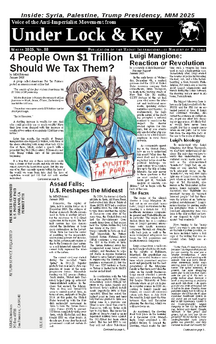
Fixing Insulin Indifference
The enclosed letter is submitted to you for follow-up to “Insulin Indifference Disables Prisoners”.(ULK 57, p. 6) The publishing editor of that letter omitted the solution to that problem. Does anyone have time to comment on if mine compares to the grievance guides presently available? Or is my method in conflict with the advice in other manuals? I want to know how I compare with other grievance methods.
The problem in the article is a policy of no lunchtime fingersticks/insulin injections. The prison serves lunch so late it is outside the timeframe that a pre-breakfast shot of 70/30 insulin works for some diabetics within the prison.
For diabetics having this problem, immediately following lunch they may have symptoms of extremely elevated glucose, like hunger (even though they have just ate lunch), blurry vision, dry mouth, thirst, pins and needles (like tingling nerve pain), and frequent urination. In addition, at next fingerstick before supper their glucose may be extremely elevated.
“Extremely elevated” blood sugar is dangerous because it “can cause life threatening changes in the body within a matter of hours. An extremely high blood sugar level… And I am talking at least 300… can cause an imbalance in the delicate acid-based structure in the tissues of the body.”(1)So if you take 70/30 insulin (and your prison doesn’t do lunchtime fingersticks/insulin injections) and you have the above symptoms, and/or if your suppertime glucose level is still over 300 several hours after lunch, then you should first try a medical request. Then, if necessary, a grievance explaining the problem. If filing a grievance (the formal step), then include the illustration of how extremely elevated glucose harms the body, located in the last paragraph of “Insulin Indifference Disables Prisoners.” This way the warden, or other prison officials signing off on the grievance, cannot claim they were unaware of the damage that was occurring due to that they “are not medical professionals.” (This is a popular excuse used by non-medical prison officials to escape liability in prison medical care cases.)
Two solutions to the problem are: 1. For the prison to start serving lunch earlier, or 2. For the prison to start providing lunchtime fingerstick/insulin injection, at which time you should receive a small dose of regular-type insulin, also called “mealtime insulin.” Immediately following these two suggested solutions on your grievance, you should write “To do neither would constitute deliberate indifference.”
In your medical request or your grievance, you should also explain that staff should periodically adjust your new lunchtime dose of regular insulin to determine exactly what amount is required to lower the residual glucose from lunch so it is at least somewhere between 200 - 300 by suppertime fingerstick. This will keep your glucose out of the danger zone between lunch and supper.
MIM(Prisons) responds: The problem with timing insulin injections with mealtimes is not lack of education or medical expertise. The problem of indifference is built in to the capitalist, white supremacist power structure. Imprisoned people, and oppressed nations in general, are not thought to need or deserve to have access to proper medical care. Prisoners’ right to their eyesight or to keep all their toes is of absolutely no concern to the imperialist power structure. In fact, from the imperialist system’s perspective it is probably better for prisoners and oppressed nation people to continue suffering, and be kept busy filing grievances. That way it’s even harder to fight back.
We’re glad this author wrote in with more details on what people could do to resolve the individual problems they are having with administration’s approach to diabetes management. If we’re talking about real remedies, though, and about fixing a problem, we need to acknowledge that capitalism and national oppression are the real cause of extremely elevated glucose levels. We need to struggle on our individual problems so we can be stronger for our revolutionary work. Don’t lose sight of the bigger picture!
Related Articles:This article referenced in:









